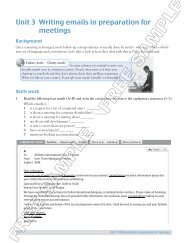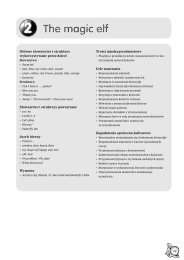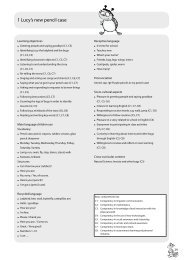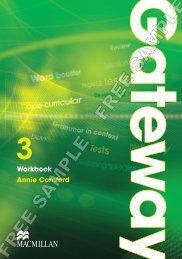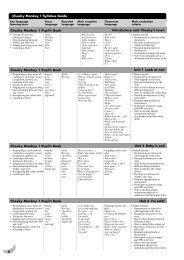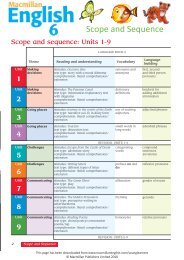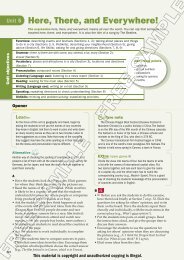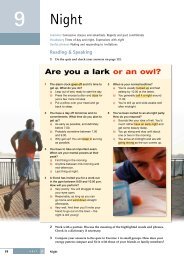9 In my life - Macmillan
9 In my life - Macmillan
9 In my life - Macmillan
Create successful ePaper yourself
Turn your PDF publications into a flip-book with our unique Google optimized e-Paper software.
12 Sumeo’s story<br />
Optional materials<br />
• a CD with music<br />
LESSON 12a<br />
<strong>In</strong>troduction<br />
Write the word island on the board. Divide students into<br />
groups of four and ask them to brainstorm all the words they<br />
associate with the topic. Set a time limit of two minutes and<br />
elicit all the groups’ words onto the board. Students open<br />
their books, look at the pictures in Activity 1a and check how<br />
many of their words appear there.<br />
1 Reading<br />
a) [1.43] Focus attention on the first picture and introduce<br />
the boy named Sumeo. Then point to the map and<br />
explain that he lives on the island of Funafala which is in<br />
Tuvalu, a small country in the South Pacific. Ask students<br />
to listen and read about Funafala and say why they think<br />
people living there are afraid for the island’s future. Play<br />
the CD.<br />
Check if students know/can guess the meaning of the<br />
following words and phrases: tiny, low, floods, net, share,<br />
main, one of these, so far away. Provide explanation if<br />
necessary. Point out that fish is uncountable in English.<br />
Elicit that people are afraid for Funafala’s future because<br />
the sea sometimes floods the island and families leave.<br />
Tapescript<br />
see Student’s Book Activity 1a<br />
b) Students read the text in Activity 1a again and decide if<br />
the sentences are true or false about Funafala. Encourage<br />
them to mark with pencil the relevant parts of the<br />
text which contain the answers. Set a time limit of five<br />
minutes. If your students like it, you can play music in the<br />
background for the duration of the activity.<br />
Students compare the answers in pairs. Check the<br />
answers with the whole class and elicit which parts of the<br />
text prove that the sentences are true or false.<br />
Mixed ability classes<br />
Fast fi nishers correct the false statements in writing.<br />
Photocopiable activity<br />
• <strong>In</strong>teresting stories, p175<br />
Extra activity<br />
Divide students into pairs. Ask Student A to study pictures 1 and<br />
2 in Activity 1a for thirty seconds. Then they should close their<br />
books and describe the pictures from memory to Student B.<br />
Student B checks if the description is correct and asks Student A<br />
at least one question about each picture, e.g. How many people<br />
are standing in the water Then students repeat the procedure<br />
with Student B studying, describing and answering questions<br />
about pictures 3 and 4.<br />
Teaching tip: Music in the classroom<br />
Music in the classroom can enhance concentration; it<br />
stimulates the brain, relaxes students and makes learning<br />
more enjoyable. You can find music related to the story<br />
in the textbook, e.g. Polynesian music (in the case of the<br />
reading activity above), and play it to help students make<br />
associations with a given place or topic. You can play music<br />
in the background for the duration of the activity, so when<br />
you pause it, students know that the time is up. To help<br />
students concentrate on grammar tasks use harmonic music<br />
with repeated patters, e.g. Mozart, and to stimulate ideas in<br />
brainstorming activities use music with irregular patterns.<br />
Answer key<br />
1 true 2 false (It is very low) 3 false (All the men are fi shermen)<br />
4 true 5 false (There are fi ve families) 6 false (They are happy)<br />
Cultural information<br />
Tuvalu is the fourth smallest country in the world. It is located<br />
between Hawaii and Australia in the Pacifi c Ocean. Tuvalu’s<br />
<strong>In</strong>dependence Day is on October 1st. Tuvalu comprises islands<br />
and atolls. Funafala is one of Tuvalu’s islets. The land on the<br />
islands is very low, the highest elevation is 5 metres above sea<br />
level. Because of the climate change and the resulting rise of the<br />
sea level, Tuvaluan islands can be partially or completely fl ooded<br />
and food crops may be destroyed by salt water in the future.<br />
Tuvaluan people are Polynesian people who settled on the islands<br />
2000 years ago. Due to the environmental threats they have now<br />
begun moving away to New Zealand.<br />
T 36<br />
FREE SAMPLE FREE SAMPLE




